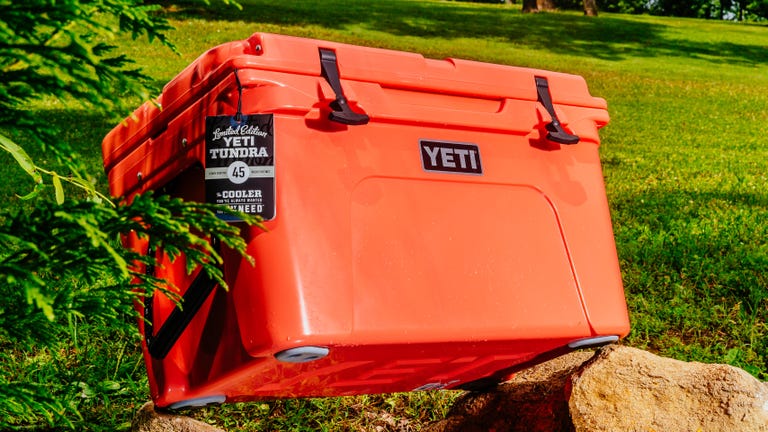 Why You Can Trust CNET
Why You Can Trust CNET Yeti Tundra 45 Cooler review: It wasn't close. Yeti's cooler crushed the competition
This expensive cooler is worth it for the outstanding performance alone -- but it isn't perfect.
If you haven't shopped for a cooler in awhile, you might be surprised by how expensive some of the latest options are. Chief among them is Yeti, a company that broke out big by selling "rotomolded" coolers that promise exceptional performance and cost hundreds of dollars. The company was so successful that it spawned a flood of rotomolded imitators.
The Good
The Bad
The Bottom Line
I'm always pretty skeptical of big performance claims at astronomically high prices, but rotomolding -- short for rotational molding -- is legit. The process is just what it sounds like; the mold gets rotated as the manufacturer pours the plastic in. The result? Plastic that's sturdier, more uniform in density and most importantly to the cooler category, better at insulation.
As such, I expected the Yeti Tundra 45 -- which costs a princely $300 -- to perform well in my tests. And boy, did it ever. Out of 12 coolers tested, it was by far the top performer, retaining ice longer than the competition and keeping ambient temperatures inside nice and low, even with a minimal amount of ice. It isn't the easiest cooler to carry, and at 38 quarts, I hate that it's 15 percent smaller than the name suggests, but if performance is what you care about (and if you're willing to spend), then look no further.
You'll find a variety of Yeti coolers on display at Dick's Sporting Goods.
Available in a variety of colors (I went with a limited-edition shade of salmon), the Yeti Tundra 45 is one of several hard-bodied Yeti coolers currently available for purchase. The design is clean, simple and sturdy as hell, with smooth, high-quality construction, roped handles and a hinged lid that locks shut with a pair of thick, rubber latches.
The thing's a tank, which is great if it's going to be banging around in the back of your truck on a road trip. Carrying it is another story. At 23 pounds when empty and with walls that are at least an inch thicker than most coolers, it's a bulky haul even without beer in it, and while the roped handles look appropriately fancy, I much prefer rigid handles that don't sway back and forth as I'm lumbering along. Fortunately, the Yeti also includes rigid handles like that just above the roped ones -- to each their own, I guess.
Those extra-thick walls might also help make for an interior that isn't as spacious as the product name suggests. Many shoppers will understandably assume that the Tundra 45 holds 45 quarts, but they'd be wrong -- I was only able to fill it with 38 quarts of water before the lid wouldn't close without overflowing.
In fairness, the folks at Yeti never make the specific 45-quart claim, and in the fine print, you'll see the Tundra 45 listed at 8.2 gallons, which comes out to about 33 quarts. Still, they know what they're doing with that "45" in the moniker. I see you, Yeti.
Yeti's cooler was our top performer, holding temperatures nice and low for longer than any other model we tested.
Now that I've said all of that, please allow me to gush about how well this cooler keeps things cold. In our tests, I packed each cooler into a 70-degree climate-controlled room, added a measly 3 pounds of ice (not even half of a small-size bag from the gas station) to each one, then tracked the ambient temperature inside on a minute-by-minute basis for 48 hours. And, to put it simply, the Yeti flat-out smoked the competition.
At the 22-hour mark of our 3-pound ice test in a 70-degree room, the Yeti (bottom right) was the only cooler that still had any ice in it at all.
To be specific, the Yeti brought the temperature inside down lower and then held it for longer than any other cooler I tested. At the end of the first day, it was the only cooler that still had ice in it at all. At the end of the second day, it was the only cooler that still hadn't returned to room temperature. At 38 quarts, it was the smallest of the 11 coolers I tested, so it had the least work to do, but even if you handicap it for its size, those are still outstanding results.
In the end, that combination of performance and durability make the Yeti a worthwhile investment for anyone who uses their cooler a lot and who can afford a bit of a splurge. But consider the Orca Classic Cooler, which also costs $300, as well. Though it didn't retain ice as long as the Yeti did, it still managed to bring the temperature down to the same threshold, making it the runner-up in our performance tests. And despite being the same price as the Tundra 45, it's notably more spacious at 58 quarts (and unlike Yeti, that capacity claim held up when I double-checked it).
If both are too expensive for you, don't worry -- there are lots of other good options that don't cost nearly as much. But if you're simply looking for the cooler that'll hold your ice the longest, this is it.
- Looking for more cooler buying advice? You, my friend, are in luck.


